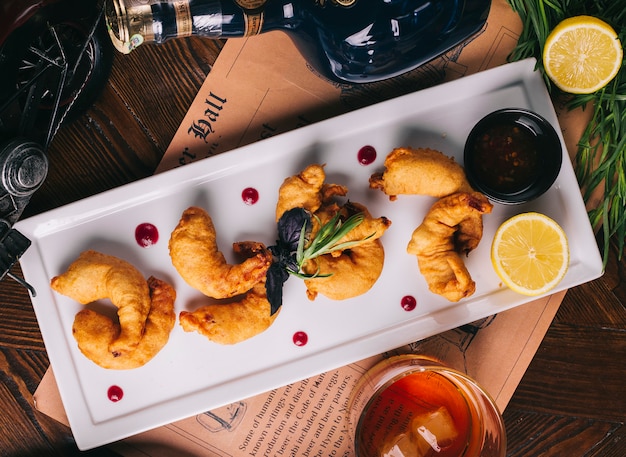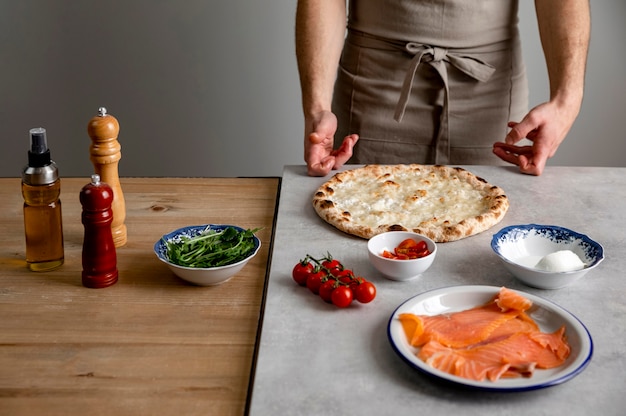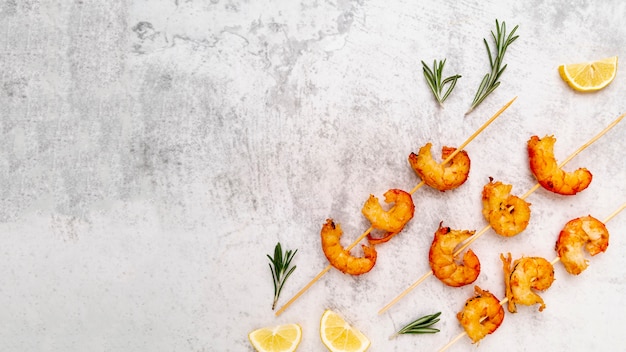Let's talk about crispy fried shrimp. Not the sad, limp, frozen kind you find in the freezer aisle, but the real deal – shrimp coated in a gloriously light and crunchy batter, then deep-fried to golden perfection. It's the kind of dish that makes you forget about your manners and dive right in, fingers licking good!
I've been on a bit of a quest for the ultimate crispy fried shrimp, trying everything from fancy restaurants to humble street food stalls. It's a journey that's led me to some real gems and a few duds along the way. The best part is, you don't need to be a professional chef to nail this dish. With the right technique and a few key ingredients, anyone can create a batch of crispy fried shrimp that's good enough to make your mates jealous.
This guide is your one-stop shop for everything you need to know about crispy fried shrimp. We'll dive into the ins and outs of choosing the best shrimp, explore different batter options, and uncover the secrets to achieving that perfect crunch. We'll even take a look at some creative twists on the classic recipe, so you can unleash your inner culinary genius.
(Part 1) Picking the perfect shrimp: The Foundation of Flavor

Freshness is Key: The Scent of the Sea
Let's start with the most important ingredient: the shrimp. You want shrimp that's fresh and firm, with a vibrant colour and a mild, sweet scent. I usually go for wild-caught shrimp whenever possible, but farm-raised shrimp can also be delicious if you pick the right kind. Avoid any shrimp that smells fishy or has a dull, greyish colour – that's a sign it's past its prime. Imagine the scent of the ocean – that's what you're looking for!
Size Matters: From Delicate to Substantial
The size of your shrimp is important, too. Smaller shrimp, like whiteleg shrimp, tend to cook faster and can be a bit more delicate. They're perfect for a light and crispy bite. Larger shrimp, like tiger prawns, are great for a more substantial bite and offer a different texture. It really comes down to personal preference. I find that medium-sized shrimp, like those you'd use for scampi, strike a good balance between size and tenderness.
Peeled and Deveined: A Little Preparation Goes a Long Way
You can get your shrimp pre-peeled and deveined, which saves a lot of time and effort. But if you're feeling ambitious (or just want to save a few quid), you can do it yourself. It's a simple process: make a small incision along the back of the shrimp, then carefully remove the dark vein running along the back. This makes the shrimp easier to eat and lessens the chance of an unpleasant surprise.
Ready to Fry: The Final Touches
Once you've got your shrimp sorted, you need to make sure they're ready for frying. Gently pat them dry with paper towels, removing any excess moisture. This will help ensure a nice crispy coating. A bit of drying goes a long way in achieving that perfect golden crust.
(Part 2) Batters and Breadings: The Quest for Crunch

Classic Tempura Batter: Light and Airy
Now we get to the fun part: the batter. A good batter is the secret to crispy fried shrimp, and there are tons of different options out there. One of my personal favourites is a classic tempura batter. It's light and airy, with a delicate crunch that doesn't overpower the flavour of the shrimp.
To make a simple tempura batter, you'll need:
- 1 cup all-purpose flour
- 1/2 cup cornstarch
- 1 teaspoon baking powder
- 1/4 teaspoon salt
- 1 cup ice-cold water
Just whisk together the dry ingredients, then gradually whisk in the ice-cold water until you have a smooth batter. Don't overmix! The key to a light and airy tempura batter is the ice-cold water. It helps create those beautiful air pockets that make the batter so crispy.
Cornstarch and Flour Mix: A Heartier Crunch
Another classic option is a simple cornstarch and flour mix. It's a bit more substantial than tempura batter, but it still delivers a lovely crispness.
To make this batter, you'll need:
- 1 cup all-purpose flour
- 1/2 cup cornstarch
- 1 teaspoon baking powder
- 1/2 teaspoon salt
- 1 cup cold milk
Simply whisk together the dry ingredients, then slowly whisk in the cold milk until you have a smooth batter. This batter is a bit more forgiving than tempura, so it's a great option for beginners.
Panko Breading: The Ultimate Crunch
If you want a really crispy, almost crackly coating, panko breadcrumbs are the way to go. They're larger and lighter than regular breadcrumbs, which creates a much more substantial crunch.
To bread your shrimp in panko, you'll need:
- 1 cup panko breadcrumbs
- 1/2 cup all-purpose flour
- 1 egg, beaten
- 1/2 teaspoon salt
- 1/4 teaspoon black pepper
First, dredge the shrimp in flour, then dip them in the egg mixture, and finally coat them generously in panko breadcrumbs. This method is great for achieving a really crispy, almost shatter-like crust.
Other Batter Options: A World of Flavor
There are countless other batter options out there, from beer batters to buttermilk batters. Feel free to experiment and find your own favourite. You can also add spices, herbs, or even shredded cheese to your batter for extra flavour. Experimentation is key! Try adding a pinch of cayenne pepper for a bit of heat, or a tablespoon of chopped fresh herbs for a burst of freshness.
(Part 3) The Art of Deep Frying: Mastering the Heat

The Right Oil and Temperature: The Foundation of Crispy Perfection
Deep frying is a bit of an art form, and it takes a little practice to get it right. The key is to use the right oil and temperature. I prefer to use vegetable oil for deep frying, as it has a high smoke point and neutral flavour.
When it comes to temperature, you want the oil to be hot enough to cook the shrimp quickly and evenly, but not so hot that it burns the batter. Aim for a temperature of 350-375°F (175-190°C). You can use a candy thermometer to check the oil temperature. If you don't have a thermometer, you can test the oil by dropping a small piece of bread into it. If it sizzles and browns quickly, the oil is ready.
The Deep-Fry Technique: Patience and Precision
Once your oil is hot, carefully lower the shrimp into the fryer, making sure not to overcrowd the pan. If you overcrowd the pan, the temperature of the oil will drop and the shrimp won't cook evenly. Fry the shrimp for 2-3 minutes per side, or until golden brown and cooked through. It's best to fry in batches, so you don't lower the temperature of the oil too much.
Draining and Cooling: Allowing the Crunch to Set In
When the shrimp are cooked, remove them from the fryer and place them on a wire rack to drain off excess oil. Let them cool slightly before serving. This will allow the crust to crisp up even more and the shrimp to cool slightly. It's important to drain the shrimp properly to prevent them from becoming soggy.
(Part 4) Seasoning and Serving: The Finishing Touches
Salt and Pepper: The Basics
The beauty of crispy fried shrimp is that it doesn't require a lot of fuss when it comes to seasoning. A simple sprinkle of salt and pepper is usually all you need. However, if you want to add a bit more flavour, try sprinkling in some paprika, garlic powder, or onion powder. Sometimes the simplest seasonings are the best.
Lemon and Lime: A Tangy Touch
A squeeze of lemon or lime juice adds a bright, tangy touch to the dish. It cuts through the richness of the fried shrimp and enhances the overall flavour. This is a classic combination that really elevates the dish.
Spicy Dipping Sauces: A Heat Wave
For those who like a bit of heat, there are a wide range of spicy dipping sauces to choose from. Sriracha, chili oil, and hot sauce are all excellent options. You can also make your own dipping sauce by combining sriracha, mayonnaise, and a little bit of honey.
Other Accompaniments: Take Your Pick
Crispy fried shrimp goes well with a variety of accompaniments. You can serve them with a side of rice, pasta, or even a simple green salad. For a more elaborate meal, serve the shrimp with a side of mashed potatoes and steamed vegetables.
(Part 5) Crispy Fried Shrimp Variations: Exploring the Possibilities
Sweet Chili Shrimp: A Sweet and Spicy Delight
This is a popular variation on the classic recipe. The shrimp are coated in a sweet and spicy sauce that's both addictive and delicious. To make sweet chili shrimp, simply toss the cooked shrimp in a mixture of sweet chili sauce, honey, and a dash of chili flakes. This is a popular option in many Asian restaurants and makes a fantastic appetizer.
Garlic Butter Shrimp: Rich and Decadent
For a more decadent option, try garlic butter shrimp. After frying the shrimp, toss them in a mixture of melted butter, garlic, and parsley. The rich and flavourful sauce will make you want to lick your plate clean. This dish is a real crowd-pleaser and pairs well with a glass of white wine.
Lemon Pepper Shrimp: Zesty and Refreshing
This variation combines the zesty flavour of lemon with the warmth of black pepper. Simply toss the fried shrimp in a mixture of lemon zest, lemon juice, and black pepper. This is a light and refreshing option that's perfect for a summer meal.
shrimp scampi: A Classic Italian Delight
This Italian classic features shrimp cooked in a garlicky white wine sauce. To make shrimp scampi, sauté the shrimp in garlic and butter, then deglaze the pan with white wine and add a splash of lemon juice. This dish is a true taste of Italy and pairs well with pasta.
shrimp tacos: A Tex-Mex Twist
Crispy fried shrimp are also delicious in tacos. Serve them in warm tortillas with your favourite toppings, such as shredded lettuce, diced tomatoes, and a dollop of sour cream. This is a fun and casual option that's perfect for a weekend lunch.
(Part 6) Tips for Success: Ensuring Crispy Perfection
Don't Overcrowd the Pan: Avoiding Sogginess
Make sure you don't overcrowd the pan when you're frying the shrimp. If you add too many shrimp at once, the temperature of the oil will drop, and the shrimp won't cook evenly. This will result in soggy shrimp, so it's important to fry in batches.
Don't Overcook the Shrimp: The Importance of Timing
Overcooked shrimp are dry and tough, so be careful not to overcook them. Once the shrimp are golden brown and cooked through, remove them from the fryer immediately. A little overcooking can make a big difference, so it's important to keep an eye on the shrimp.
Rest Before Serving: Allowing the Crust to Set
Let the shrimp rest for a few minutes before serving. This will allow the crust to crisp up even more and the shrimp to cool slightly. This is a crucial step in ensuring a perfect crunch.
Store Leftovers Properly: Preserving the Flavor
If you have any leftover fried shrimp, store them in an airtight container in the refrigerator for up to 3 days. You can reheat them in a preheated oven or air fryer. It's best to reheat the shrimp in a single layer to prevent them from becoming soggy.
(Part 7) FAQs: Answering Your Questions
1. How do I know if the oil is hot enough?
You can use a candy thermometer to check the oil temperature. It should be between 350-375°F (175-190°C). You can also test the oil by dropping a small piece of bread into it. If the bread sizzles and browns quickly, the oil is ready. A simple test, but an effective one.
2. What if my shrimp are not cooked through?
If your shrimp are not cooked through, you can fry them for a little longer. Just make sure you don't overcook them. Overcooked shrimp will be dry and tough, so it's important to check the shrimp's doneness.
3. Can I use a different type of oil for deep frying?
Yes, you can use a different type of oil, but it's important to choose one with a high smoke point. Some good options include canola oil, peanut oil, and avocado oil. Each oil will have a slightly different flavour, so experiment to see which one you prefer.
4. Can I make this dish ahead of time?
You can bread the shrimp ahead of time and store them in the refrigerator for up to 24 hours. Just make sure you don't fry them until you're ready to serve. This can save you time on busy nights, but be sure to fry the shrimp as close to serving time as possible.
5. What are some other ways to enjoy crispy fried shrimp?
Crispy fried shrimp can be added to salads, pasta dishes, and sandwiches. They can also be served as an appetizer with a dipping sauce. Get creative and experiment with different ways to enjoy this versatile dish.
(Part 8) Conclusion: A Culinary Triumph
There you have it, folks – your ultimate guide to crispy fried shrimp. Now you've got all the knowledge you need to create a batch of golden, crunchy perfection right in your own kitchen. Remember, the key is to use fresh ingredients, follow the techniques carefully, and don't be afraid to experiment with different batter options and seasonings.
So, grab your apron, gather your ingredients, and get ready to impress your taste buds (and maybe your mates) with a delicious, home-cooked feast of crispy fried shrimp. Happy frying!
Everyone is watching

Prime Rib Roast Cooking Time Chart: Per Pound Guide
Cooking TipsPrime rib roast. Just the name conjures images of lavish dinners, crackling fires, and hearty laughter. It’s ...

How Long to Bake Potatoes in the Oven (Perfect Every Time)
Cooking TipsBaked potatoes are a staple in my kitchen. They're incredibly versatile, delicious, and surprisingly easy to m...

Perfect Rice Every Time: The Ultimate Guide to Cooking Rice
Cooking TipsAs a self-proclaimed foodie, I've always been a bit obsessed with rice. It's the foundation of countless cuisi...

The Ultimate Guide to Cooking Asparagus: Tips, Techniques, and Recipes
Cooking TipsAsparagus. The mere mention of this spring delicacy conjures up images of vibrant green spears, crisp and burs...

Ultimate Guide to Cooking the Perfect Thanksgiving Turkey
Cooking TipsThanksgiving. Just the word conjures up images of overflowing tables laden with delicious food, the scent of r...
